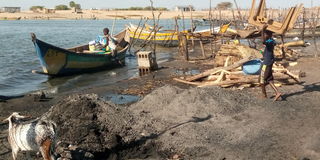Fears of cholera, kala-azar outbreaks as Lake Turkana continues to swell

Children helping in loading a boat in preparation for migration to higher grounds as a result of the swelling Lake Turkana.
What you need to know:
- Three villages in Turkana Central Sub-County, according to a February 27 cholera situation report, accounted for 225 cholera cases and one fatality.
- Turkana County Disaster Management Executive Benson Lokwang confirmed that there is an ongoing assessment by a multi-sectoral team to determine the extent of damage, destruction and the health risks caused by the swelling lake.
Residents of Turkana county living along the shores of the currently swelling Lake Turkana have expressed fear of an outbreak of cholera and visceral leishmaniasis (kala-azar) diseases.
Longech, Kalokol and Namukuse villages, which both have poor access to clean, safe and affordable water as well as poor toilet coverage, are among the affected villages in Turkana Central Sub-County where locals have been displaced after houses and toilets near the lake were submerged.
The three villages, according to a February 27 cholera situation report, accounted for 225 cholera cases and one fatality.
Mr Peter Nang'ori appealed for immediate distribution of water purification tablets as many villagers rely on unsafe water for domestic use.
Mr Nang'ori said that fishing activities have also been affected as reliable and clean drying sites along the shore have also been submerged.

Women at Lokitoe Ang'aberu village in Turkana North Sub County ponder their next move after their manyattas were swept away by the swelling Lake Turkana.
In Kataboi and Lokitoe Ang'aberu villages in Turkana North Sub-County, besides fears for possible cholera outbreak, the villagers said that they have witnessed an increase in sand flies.
"Moisture in the sand resulting from the swelling lake is providing a conducive atmosphere for breeding of sand flies whose bites transmit Leishmania parasites." Lakezone MCA Leah Nachere said.
She called for medical outreach programmes for kala-azar in villages along the shores of the lake targeting locals.
"I appeal for resettlement of the affected families who might be exposed to harmful insects by sleeping in the cold, relief food to boost immunity as well as distribution of insect repellents and insecticides as a prevention measure," the MCA said.
Extent of damage
Turkana County Disaster Management Executive Benson Lokwang confirmed that there is an ongoing assessment by a multi-sectoral team comprising officers from the departments of Trade, Tourism, Water, Environment, Health and Fisheries to determine the extent of damage, destruction and the health risks caused by the swelling lake.
"Immediate responses like prevention of water-borne diseases especially in Kalokol, which is among the worst-hit villages, won't wait till the report is compiled. The department of health has been notified to work on preventive measures so that we don't lose lives as a result of a delayed response." Mr Lokwang said.
He said that during the assessment, the officials have also been charged with the responsibility of identifying suitable higher grounds in Lakezone, Kalokol, Kerio Delta and Kangatotha wards to resettle affected villagers.

A submerged manyatta at Longech along the shores of Lake Turkana.
"The assessment report will provide us with details of the damage to guide us when coming up with a plan on how all stakeholders can intervene to save the situation. Public institutions like schools and churches have been affected," the county official said.
He said that the swelling of the lake, which now extends more than 800 meters from the shoreline, is attributed to flash floods resulting from heavy rains pounding southern Ethiopia since last year.
He noted that there has been continued flooding in southern Ethiopia, directing the flood waters to Omo River, the main source of water for the lake.





